Abstract
Shallow gas, with huge resources, has been confirmed using three dimensional (3D) seismic data and more than 20 drilling sites in the deep water of the LS36 gas field, the Qiongdongnan Basin, the South China Sea. The interface of sedimentary facies in the southern boundary of the basin controls the distribution within the basin of clastic sediments coming from the north and west of the land uplifted. In this study, seismic data and geophysical attributes were used to investigate the controlling effect of the interface of sedimentary facies on the distribution of shallow gas within the basin. Our study shows that the shallow gas is mainly distributed in the Quaternary Ledong Formation in the southwest of the Qiongdongnan Basin, which was observed from acoustic impedance, amplitude versus offset (AVO), and seismic interpretations. The channelized submarine fans that onlap the interface of the sedimentary facies are distributed in a vertically stacked manner and are the main reservoirs for the shallow gas. Therefore, these sedimentary studies show that the sand-rich sediments are distributed along the interface of the sedimentary facies from the southwest to the northeast and are limited to the shallow gas within the basin. The Central Canyon provides an important deep gas source, while the flank of the canyon, gas chimney, and normal faults related to basement uplift provide pathways for vertical and lateral gas migration to form the shallow gas. This study shows that shallow gas may be widely distributed in other marginal sea basins, and sedimentary systems should be further studied in the future.
1. Introduction
Deep-water shallow gas generally refers to the natural gas that is present in water depths greater than the shelf-break zone (200–300 m) and accumulates in reservoirs in unconsolidated shallow strata (within 500 or 800 m below the seafloor) [1,2]. It is characterized by shallow burial, a variety of gas sources, diverse reservoir–caprock combinations, and a wide distribution. Due to exploitation issues such as high costs and low resource abundance, previous studies have regarded shallow gas as an engineering and geological hazard and that oil/gas drilling needs to avoid it [3,4,5]. In 2024, the China National Offshore Oil Corporation (CNOOC) discovered that a shallow field with a reserve of tens of billions of cubic meters, named as the LS36-1 gas field, was confirmed in the Lingshui Sag, the Qiongdongnan Basin, the South China Sea [6,7,8]. Shallow gas in deep-water areas has higher pressure and lower temperature; thus, it has high resource abundance and great potential. Previous studies have shown that shallow gas is present in the near seabed strata, is associated with gas hydrates, and is prone to leakage on the seabed [9,10,11,12,13,14]. It is closely related to engineering and scientific research such as that on seabed geological disasters, ocean acidification, and gas hydrate exploitation.
Research on deep-water shallow gas in oceans is relatively rare. Offshore gas fields with a burial depth of less than 500 m are mainly distributed in areas such as the Bay of Bengal [15], the North Sea [16], the Mediterranean Sea [17], offshore from Turkey [18], the Krishna–Godavari Basin in India [19], and the Japan Sea [4]. The most representative deep-water shallow gas fields are the Dhirubhai 22 and Dhirubhai 29 gas fields in the Bay of Bengal, and the water depth ranges from 1400 to 1832 m. The gas reservoir is located at 268 and 300 m below the seafloor, the strata age spans from the Mesozoic to the Cenozoic period, and the trap types are structural traps and lithologic–structural traps [20]. In comparison, the reservoir of the LS36-1 gas field in the Qiongdongnan Basin is younger, belonging to Quaternary strata. Analyzing its reservoir and fluid migration system can provide theoretical guidance for the shallow gas exploration in international sea areas.
Numerous middle and deep gas fields have been discovered in the Qiongdongnan Basin, including the Deep-Sea No. 1 gas field in the Central Canyon and the deep BD21-1 gas field, which offer abundant gas source conditions for shallow gas accumulation [21]. The west of the Qiongdongnan Basin is near to the Vietnam Uplift and the Hainan Uplift. Multiple fluvial systems form small deltas in the shallow-water area, providing a favorable terrigenous sedimentary system for the deep-water area (Figure 1). Additionally, carbonate reefs are located in the southern uplifts of the Xisha Islands, making it a favorable area for endogenic clastic sedimentation and carbonate turbidite sedimentation. Moreover, the platform edge reefs of the Xisha Uplift may provide endogenic clastics and carbonate turbidite deposits for the southern uplift of the Qiongdongnan Basin [22]. The interface of sedimentary facies’ transition has developed between the northern sag and the southern uplift of the Qiongdongnan Basin (Figure 2), controlling the differences in sedimentary distribution patterns on both sides since the Pliocene period [23]. However, systematic research on shallow gas accumulation and distribution is lacking in the southwest of the Qiongdongnan Basin.
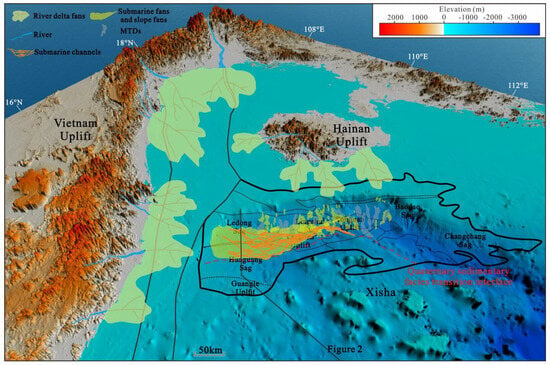
Figure 1.
The current topographic map of the northwestern continental margin of the South China Sea showing the Qiongdongnan Basin and its internal tectonic regions. The Vietnam and Hainan Uplifts supply terrigenous clastics for sedimentation, and submarine fans, slope fans, and MTDs are distributed in the Qiongdongnan Basin. The channels are revised from [24] and the sand distribution in the northern slope is revised from [7].
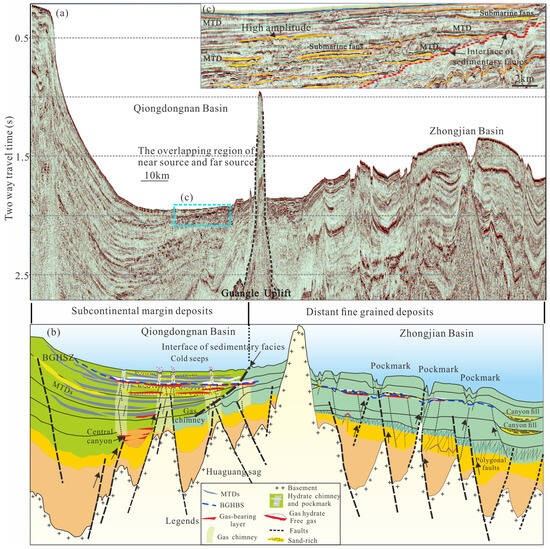
Figure 2.
Seismic profiles (a) and interpretation profiles (b) across the Qiongdongnan Basin and the Zhongjian Basin showing that a large amount of clastic sediment is deposited in the northern sag of the interface of sedimentary facies transition within the Qiongdongnan Basin. (c) is the enlarged seismic profile, which shows a large number of submarine fan deposits in the north of the interface of sedimentary facies transition. The location of the seismic profile is shown in Figure 1.
In this study, we analyze the reservoir characteristics and the geophysical properties related to shallow gas in the Qiongdongnan Basin using two dimensional (2D) and three dimensional (3D) seismic data to show the spatial distribution of shallow gas. Through comprehensive geophysical inversion and seismic interpretation, we summarize the main geological controlling factors of the shallow gas distribution in the southwest of the Qiongdongnan Basin and provide a geological model reference for deep-water shallow gas exploration.
2. Geological Setting
The South China Sea (SCS) is situated at the junction of the Eurasian, Pacific, and Indo-Australian tectonic plates, and its tectonic evolution has been shaped by processes such as rifting, subduction, collision, strike–slip movement, and mantle plume activity [25,26,27,28], resulting in a complex geological structure. Cenozoic rifting has led to the formation of a series of rift basins. The Qiongdongnan Basin is located in the northwest margin, the SCS, encompassing an area of ~80,000 km2, with water depths ranging from 80 to 3000 m [8]. The evolution has progressed through three distinct stages: the faulting stage, the fault–depression transition stage, and the depression stage. Numerous NE-SW trending faults [29] subdivide the basin into several depressions, such as the Ledong depression and the Lingshui depression, as well as many uplifts. This geological configuration illustrates a tectonic pattern characterized by “north–south into belts and east–west into blocks” in the plane view. In profiles, the stratigraphy of the basin is delineated by breakup nonconformity (~23 Ma), leading to a structural arrangement described as “rifts in the lower part and depressions in the upper part” [30,31]. The Lingtou Formation and Yacheng Formation, which were deposited during the rifting period, host hydrocarbon source rocks associated with lacustrine and land–sea transition environments, respectively [32]. The Lingshui Formation, formed during the rifting–depression transitional stage, is characterized by deltaic and braided river sand deposits, which serve as effective hydrocarbon reservoirs within the basin. Additionally, the Sanya Formation, Meishan Formation, Huangliu Formation, Yinggehai Formation, and Ledong Formation all developed during the depression period and display gravity-flow deposits, submarine fan sands, and mudstone deposits [8]. Among these, the submarine fan sands in the Ledong Formation provide favorable reservoirs for the accumulation of shallow gas, while the mass transport deposits (MTDs) and mudstone deposits serve as favorable caprocks.
Sedimentation in the basin is distinguished by a prominent double-source system. During the rifting period, sediment sources were primarily derived from the Xisha uplift, the Indo-China Peninsula, and the South China margin, while in the depression period, sediment contributions predominantly came from the Indo-China Peninsula. In the late Quaternary period, these north–south sedimentary sources converged in the deep-water regions of the basin, resulting in a notable boundary of sedimentary facie change [23]. Since the Late Miocene period, due to paleo-topographic, the central sag area controlled the sedimentation process of clastic materials within the basin and received sediments from the uplifts in the north, west, and south [33]. In the Qiongdongnan Basin, fluid-related structures have been well discussed, including polygonal faults [34], gas chimneys [35], hydrothermal vents [36], cold seeps [37], mud volcanoes [38], and magmatism [39,40,41]. These structures highlight that there are abundant hydrocarbon-rich fluids within the basin, which migrate upward along the faults and gas chimneys above the structural uplifts, connecting the deep gas sources with the shallow reservoirs (Figure 2). Faults and gas chimneys serve as the primary vertical migration pathways for fluids [35,38], which contrast significantly with the fluid migration system observed in the Zhongjian Basin (Figure 2). In the Zhongjian Basin, the vertical migration system is primarily governed by a combination of basement faults and polygonal faults [42], with gas and gas hydrates chiefly stored in marginal platform fans or fine-grained sediments [43]. Fluid migrates to the seafloor, leading to the formation of pockmarks on the seafloor [43,44]. Therefore, there is a quite different sedimentary environment for the Qiongdongnan Basin and Zhongjian Basin, which influence the shallow gas, gas hydrate, and deep gas distribution (Figure 2).
3. Data and Method
Two-dimensional seismic data acquired in 2005 were reprocessed by the China National Petroleum Corporation (CNPC) in 2020 and 2023 to study gas hydrates and shallow gas in the southwest of the Qiongdongnan Basin. The reprocessing of the seismic data included improving the signal-to-noise ratio, preserving low frequencies, and broadening frequency bandwidths. The stack velocity obtained during reprocessing was used to invert acoustic impedance based on constrained sparse spike inversion (CSSI) due to the limitation of a well log in the study area. CSSI can effectively identify and quantitatively evaluate gas hydrate-bearing sediments and underlying free gas-bearing sediments, which has been applied in previous studies [7,18,45,46]. The wavelet is extracted from seismic data in shallow sediments. The low-frequency velocity model used in CSSI has been combined with stack velocity from seismic processing and the velocity trend at Site LS36-1c [8]. The inversion method has been widely used to delineate gas hydrate layers [45,46,47].
For gas hydrate- and free gas-bearing layers showing different responses, P-wave and S-wave velocities show obvious increases for gas hydrate-bearing layers, while P-wave velocity decreases greatly and S-wave velocity shows a slight increase when free gas is present in the sediment. Moreover, gas-bearing layers also show absorption attenuation anomalies for high frequencies. The amplitude versus offset (AVO) shows different changes which can be used to identify hydrocarbon gas. The velocity field from the seismic data processing was introduced to obtain more realistic and objective AVO intercept and gradient attributes, minimizing the impact during the conversion process from the offset to the incident angle. The AVO attributes for the intercept (I) and gradient (G) were obtained to show shallow gas and gas hydrates [48]. The intercept profile reflects the intensity of P-wave reflection at a normal incidence, and the gradient profile reflects the rate of change in the reflection amplitude with the incident angle. For gas hydrate layers, the AVO of BSR shows a Class III type anomaly [48]. Shallow gas, faults, channels, and polygonal faults were identified from the coherence, root mean square (RMS) amplitude, and instantaneous frequency attributes. The shallow gas had a high amplitude, was laterally discontinuous, and had enhanced reflections observed from seismic amplitude anomalies. Therefore, the attributes of the seismic data, AVO, and inversion were combined to delineate shallow gas in the southwest of the Qiongdongnan Basin.
4. Results
4.1. Shallow Gas Identification and Distribution
Drilling for gas hydrates and shallow gas has been carried out in the LS36-1 gas field [7,8,24,35,49]. The results show that in the well logs, the shallow gas layer is characterized by high resistivity, a significantly decreased P-wave velocity, and a slightly increased S-wave velocity. In the seismic profiles, it corresponds to a bright spot or enhanced reflections with reverse-polarity reflections compared to the seafloor reflection [7,8,24]. Therefore, shallow gas could be identified based on 2D and 3D seismic profiles and the anomalies of acoustic impedance, frequency, and AVO. The arbitrary seismic profile from LS36-1 in the south part of the Qiongdongnan Basin is used to show the shallow gas properties (Figure 3). Numerous enhanced reflections are widely distributed in the channel–levee system or submarine fan area, which are nearly parallel. There are multiple MTDs showing weak, chaotic, and discontinuous seismic reflections in the seismic profiles, which erode the lower sediments and form different-sized grooves (Figure 3). Many small channels are also formed which also erode the lower formation and are filled with clay-rich sediments. The high amplitude reflections are partially related to the base of the MTDs.
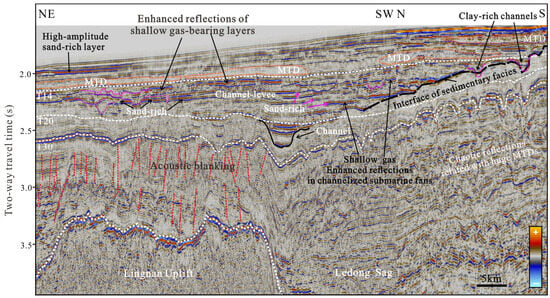
Figure 3.
Seismic profiles showing the sedimentary facies’ transition interface and internal shallow gas, submarine fans, channels, and MTDs. The location of the seismic profile is shown in Figure 4.
The shallow gas is interpreted from the seismic anomalies showing the fan-shaped distribution (Figure 4). The shallow gas is mainly distributed in Ledong Formation with three layers. The shallow gas identified from the seismic data in the southwest is mainly distributed in the prosperous and degenerating stages of the submarine fans, as can be seen with the LS36-1 shallow gas. Most of the shallow gas is located in the Ledong Sag and Huaguang Sag. In the HaiMa cold seeps, shallow gas is also widely distributed. The distribution of the shallow gas shows two directions and then converges to LS36-1.
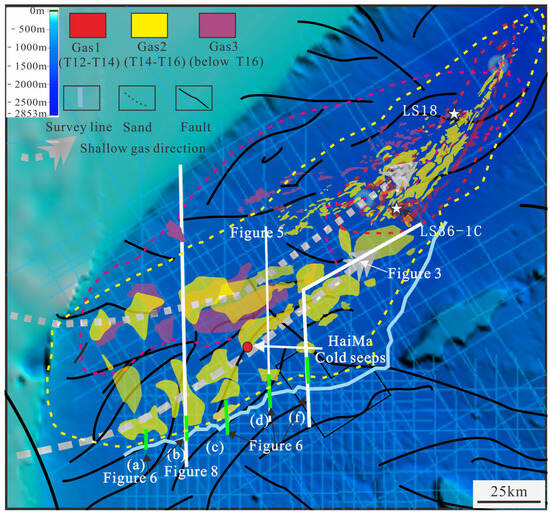
Figure 4.
Shallow gas distributions in three layers and a sand-rich reservoir identified from 2D/3D seismic data showing the submarine fan-like distribution. The shallow gas in the LS 36-1 is revised from [7,8]. The thick white line represents the location of the whole seismic profiles, such as Figures 3, 5, and 8, while the green line indicates the scope of the seismic profiles used in Figure 7.
4.2. Geophysical Properties of Shallow Gas
For the sand-rich gas-bearing layers, the measured P-wave velocity from logging while drilling quickly decreases, with a value as low as 800 m/s, and the density also decreases, which forms a negative reflection coefficient interface and enhanced reflection in the seismic profiles [8]. For the gas hydrate-bearing layers, the P-wave velocity is about 2200 m/s and the seismic profile shows a positive reflection. Therefore, the characteristics of seismic reflection can be used to judge shallow gas, gas hydrate, and water-saturated sediments. The data from logging while drilling at Site LS36-1 show a low P-wave velocity, a higher S-wave velocity, and low P-wave-to-S-wave velocity ratios for the gas-bearing layers, and the AVO shows Class III–IV anomalies. Shallow gas reservoirs belong to unconsolidated high-porosity strata, and the top boundary of the reservoir exhibits typical Class III AVO anomalies. AVO is attributed with a negative intercept and a negative gradient. When the shallow gas reservoir has a gas hydrate cap, the velocity is relatively high, and the top boundary of the reservoir sometimes shows typical Class IV AVO anomalies, which are similar to the negative intercepts of Class III AVO anomalies.
The acoustic impedance profiles were inverted using the reprocessed seismic data based on CSSI (Figure 5) to identify shallow gas. The seismic profile shows an obvious change from negative to positive reflection for the same layer (Figure 5b), while the instantaneous frequency from the seismic profile also shows low frequency for the same layer where pull-down reflections occur (Figure 5c). The inverted P-wave velocities clearly show high and low values at interfaces which are obviously higher than those of the bases of mass transport deposits (Figure 5d). Gas chimneys showing chaotic and pull-down reflections with local enhanced reflections are observed below this anomalous zone, which indicate fluid migration along the gas chimneys (Figure 5a).
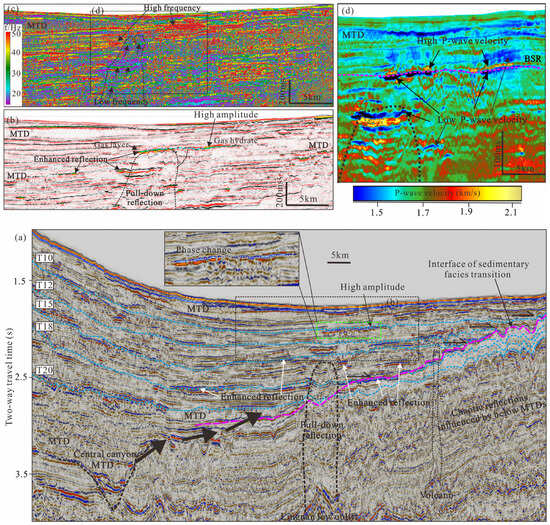
Figure 5.
(a) Seismic profiles showing enhanced reflections related to submarine fan systems and shallow gas. (b) An enlarged seismic profile showing positive and negative amplitude anomalies and pull-down reflections. (c) The instantaneous frequency profile shows low frequency for the gas-bearing layers and high frequency for the gas hydrate-bearing layers. (d) The inverted P-wave velocity from constrained sparse spike inversion (CSSI) showing the anomalies. The location of the seismic profile is shown in Figure 4.
The seismic anomalies and acoustic impedance show the occurrences of shallow gas and gas hydrate (Figure 5). However, the shallow gas with enhanced reflections shows multiple layers which are terminated at the sedimentary interface boundary. To confirm and delineate the anomalies, the intercept profile (P), gradient profile (G), and product of the intercept and gradient profile (P × G) of the AVO were extracted from the gathered data to show the reservoir properties and pore fluids (Figure 6). The P profile is near to the zero-offset profile showing the normal incidence reflection coefficient which can be used to identify hydrocarbon gas. The G profile can show the amplitude variation with the offset. For the gas hydrate-bearing layers near the BSR, the P profile shows a positive and strong value (Figure 6 upper), while the G and P × G profiles show negative values (Figure 6 lower). For shallow gas in free-gas layers, the P × G profile is sensitive to fluids showing strong and positive values in the deeper layers (Figure 6 lower).
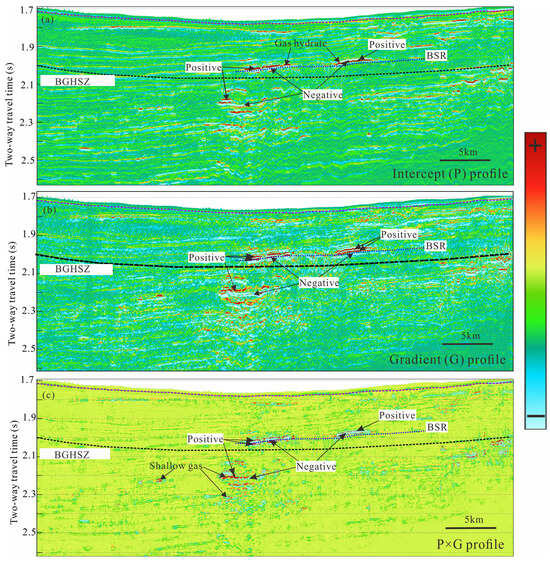
Figure 6.
AVO attribute profiles show intercept profile (P), gradient profile (G), and product of intercept and gradient profile (P × G) for seismic profile of Figure 5b.
4.3. Sedimentary Facies’ Identification
In the southern Qiongdongnan Basin, there is an interface of sedimentary facies’ transition trending nearly east–west with a dip angle of ~1.1°. This interface initiates along the southern sidewall of the Central Canyon and coincides with the T30 interface, with an initial development age of ~5.5 Ma (Figure 2 and Figure 3). It overlays the southern uplift, separating the northern sag from the southern Guangle uplift. The interface of the sedimentary facies’ transition exhibits diachronous characteristics, extending from the T30 interface near the seabed and separating the Ledong Formation and Yinggehai Formation (Figure 3).
The seismic profile interpretations and the lateral variations in the stratigraphic thickness indicate that, due to its higher topography and greater distance from the sediment sources, the southern uplift mainly receives fine-grained terrestrial clastic and carbonate sedimentations, which are characterized by low deposition rates, near-parallel and continuous seismic facies, and a strong vertical inheritance of topography. In contrast, the northern sag receives a significant amount of terrestrial clastic materials, with depositional systems dominated by Ledong Formation submarine fans sourced from the western uplift, slope fans, and MTDs sourced from the northern shelf uplift, exhibiting high deposition rates (Figure 1) [7]. The submarine fan exhibits lenticular and strong amplitude reflections. The channel is marked by an erosional surface that cuts into the strata, and its interior can be filled with either strong-amplitude or weak-amplitude reflections. The MTDs develop distinct strong-amplitude top and bottom interfaces, with blanking and chaotic characteristics inside. Multiple well-connected muddy channels are visible above the submarine fans. MTDs and submarine fans are usually interbedded deposits. The interiors of channels can be filled with sandstone or mudstone sediments. Locally, the sedimentary facies’ transition interface also shows the occurrence of channels (Figure 7). Within the submarine fans, there are negative-polarity and strong-amplitude reflections, which are locally segmented by channels, which are the identifications of shallow gas.

Figure 7.
Continuous seismic profiles showing the spatial distribution of the sedimentary facies’ transition interface, which separates the continuous fine-grained sediments in the south from the coarse-grained sediments in the north of the Qiongdongnan Basin. The seismic profiles from (a–g) are distributed from west to east, and the location of the seismic profiles are shown in Figure 4.
5. Discussion
5.1. The Formation of the Sedimentary Facies’ Transition Interface
From the perspective of macroscopic “source–pathway–sink” analysis, the river systems in the Vietnam and Hainan Uplifts form delta fan systems in the shallow-water continental shelf (Figure 1). When the sea level drops and the sediment supply increases, terrigenous clastics enter the continental slope and the deep-water sag area through the shelf break [50]. Since the Pliocene period, shelf breaks have emerged in the northern and western area of the Qiongdongnan Basin, marking the onset of a stage of rapid subsidence [51,52]. With an abundant sediment source in the north and west, the continental shelf has advanced rapidly seaward. The channels that developed in the continental shelf and slope areas during the Pliocene and Miocene periods indicate an enhanced ability to transport sediments seaward (Figure 3 and Figure 8) [24]. In this geological setting, a large number of interbedded submarine fans, slope fans, and MTDs can be observed in the north of the sedimentary facies’ transition interface (Figure 3, Figure 5, Figure 6 and Figure 8). Topography is a prerequisite for sedimentation, determining the location of the sedimentation center and the distribution and morphology of sedimentary systems [53]. Due to the relatively high paleo-topography in the southern uplift, the sag area is continuously filled with sediments, and the submarine fans are distributed along the sedimentary facies’ conversion interface and gradually converge from west to east in plain view (Figure 3 and Figure 8). Apart from submarine fans, MTDs and bathyal sediments are also preferentially deposited in the sag, onlapping onto the southern uplift area, thus forming the sedimentary facies’ transition interface. Therefore, the sedimentary facies’ transition interface is caused by the differential deposition of sediments in the northern sagging subsidence area and the southern uplift area under the control of topography.
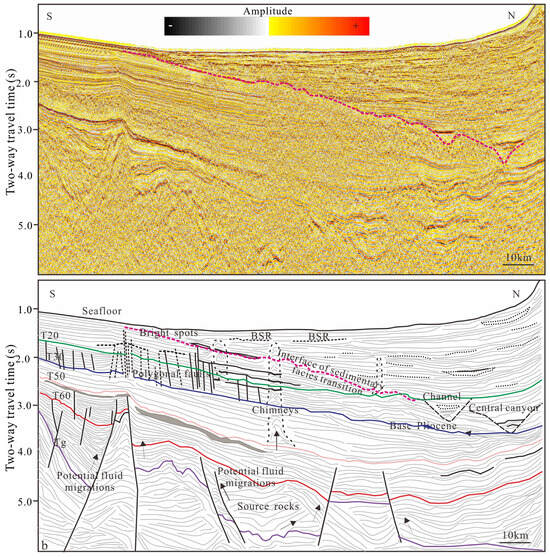
Figure 8.
A shallow gas accumulation model in the southwest of the Qiongdonganan Basin showing submarine fan-shaped distributions under the control of the sedimentary facies’ transition interface. The location of the seismic profile is shown in Figure 4.
5.2. Influence on Shallow Gas and Gas Hydrate Distribution
The geochemical indicators of the cores from the shallow gas drilling Sites 01 and 03 in the Qiongdongnan Basin indicate that the gas source of the shallow gas in the study area is a mixture of biogenic gas and thermogenic gas. Thermogenic gas usually originates from the continental coal source of the deep Yacheng Formation and Lingshui Formation, while biogenic gas comes from the marine source rocks of the Huangliu Formation and Yinggehai Formation [8]. The fluid migration system serves as a passage for biogenic gas and thermogenic gas from source rocks to reservoirs. The first function of the sedimentary facies’ transition interface in shallow gas accumulation is to act as a fluid migration pathway, which laterally transports hydrocarbon gasses trapped within the Central Canyon, as well as those from deep sources and shallow strata into shallow sandy reservoirs (Figure 5). Faults and gas chimney structures, on the other hand, are important conditions for the vertical migration of fluids (Figure 5, Figure 7 and Figure 8).
The sedimentary facies’ transition interface may form lithologic traps for shallow gas with reservoirs such as submarine fans. Seismic interpretations and attribute studies show that the shallow gas in the Qiongdongnan Basin is mainly enriched in coarse-grained reservoirs such as submarine fans and slope fans [7,8]. Compared to the Qiongdongnan Sea, the reservoirs of the Dhirubhai 22 and 29 gas fields in the Bay of Bengal are of an older age, belonging to the Mesozoic to the Cenozoic strata. Similarly, lithologic traps and structural traps also play important roles [20]. The coarse-grained reservoirs, due to their continuous onlap onto and pinching out at the sedimentary facies’ transition interface, form a lithologic trap (Figure 8). In addition, a large number of channels develop above the sedimentary facies’ transition interface, which serve as important transport pathway for sandy sediments [54]. When sandy sediments are deposited in the channels, these channels can also function as reservoirs for shallow gas and gas hydrates. When the shallow gas reservoir is located above the base of the gas hydrate stability zone, the shallow gas forms gas hydrates. Sandy gas hydrate reservoirs composed of submarine fans have been discovered in the LS36-1 gas reservoir area of the Qiongdongnan Basin [24]. However, when the channels are filled with muddy sediments, the shallow gas is separated by the channels and, together with MTDs, the muddy filled channels act as a caprock for the shallow gas (Figure 8).
6. Conclusions
The interface of the sedimentary facies’ transition, formed since the Pliocene period, divides the northern sag area and the southern uplift area of the Qiongdongnan Basin, which causes the sediments to change from rapid deposition to slow deposition. The seismic facies show obviously different reflections. The enhanced reflections, low acoustic impedance, low frequency, and AVO attributes indicate the widely developed shallow gas in the high-deposition zone and are significantly controlled by the interface of the sedimentary facies’ transition. The difference in paleo-topography between the northern sag and the southern uplift leads to different sedimentations, thus forming an interface of sedimentary facies’ transition between the two areas. During the process of shallow gas reservoir formation, the sedimentary facies’ transition interface can act as a lateral migration channel for fluids, form lithologic traps together with submarine fans, and trap the shallow gas within local channels. This work emphasizes the widely distributed shallow gas along the sedimentary facies between different sources in the Qiongdongnan Basin. There has been relatively little research on shallow gas in international oceans. However, the discovery of the shallow gas field LS36-1 in the Qiongdongnan area indicates that it may be widespread in international marine waters. Nevertheless, it has not attracted the attention of the industrial community yet, which highlights the significance of this study.
Author Contributions
All authors contributed equally. All authors have read and agreed to the published version of the manuscript.
Funding
This work is supported by the International Science and Technology Cooperation Program of China (2023YFE0119900), DE Research on key technologies of deep-water oil and gas exploration and evaluation (2024ZZ56), and the exploitation mechanism and technology of natural gas hydrates (024DJ96).
Institutional Review Board Statement
Not applicable.
Informed Consent Statement
Not applicable.
Data Availability Statement
The data presented in this study are available on request from the corresponding author due to (specify the reason for the restriction).
Conflicts of Interest
Authors Taotao Yang, Xiaohan Li and Jianwei Chen were employed by the company China National Petroleum Corporation Limited Southern, Petroleum Exploration and Development Co., Ltd. The remaining authors declare that the research was conducted in the absence of any commercial or financial relationships that could be construed as a potential conflict of interest.
References
- Davis, A.-M. Shallow gas: An overview. Cont. Shelf Res. 1992, 12, 1077–1079. [Google Scholar] [CrossRef]
- Fleischer, P.; Orsi, T.-H.; Richardson, M.-D.; Anderson, A.-L. Distribution of free gas in marine sediments: A global overview. Geo Mar. Lett. 2001, 21, 103–122. [Google Scholar]
- Fonnesua, M.; Palermo, D.; Galbiati, M.; Marchesini, M.; Bonaminia, E.; Bendias, D. A new world-class deep-water play-type, deposited by the syndepositional interaction of turbidity flows and bottom currents: The giant Eocene Coral Field in northern Mozambique. Mar. Pet. Geol. 2020, 111, 179–201. [Google Scholar] [CrossRef]
- Horozal, S.; Chae, S.J.; Kim, D.-H.; Seo, J.-M.; Lee, S.-M.; Han, H.-S.; Cukur, D.; Kong, G.-S. Seismic evidence of shallow gas in sediments on the southeastern continental shelf of Korea, East Sea (Japan Sea). Mar. Pet. Geol. 2021, 133, 105291. [Google Scholar] [CrossRef]
- Hasan, M.N.; Pepper, A.; Mann, P. Basin-scale estimates of thermal stress and expelled petroleum from Mesozoic-Cenozoic potential source rocks, southern Gulf of Mexico. Mar. Pet. Geol. 2023, 148, 105995. [Google Scholar] [CrossRef]
- Liu, K.; Cheng, P.; Tian, H.; Song, P.; Hu, W.-Y. Development model of shallow lithologic traps and natural gas accumulation mechanisms in marine deep-water areas: A case study in the Qiongdongnan basin, South China Sea. Mar. Pet. Geol. 2023, 151, 106211. [Google Scholar] [CrossRef]
- Pei, J.; Liu, E.; Song, P.; Yan, D.; Luo, W.; Zhan, J.; Wang, Z.; Li, G.; Uysal, I.T.; Yang, P. Influencing Factors and Model of Shallow Gas Enrichment in the Quaternary Sediments of the Qiongdongnan Basin, South China Sea. J. Mar. Sci. Eng. 2024, 12, 1928. [Google Scholar] [CrossRef]
- Xu, C.-G.; Wu, K.-Q.; Pei, J.-X.; Hu, L. Enrichment mechanisms and accumulation model of ultra-deep water and ultra-shallow gas: A case study of Lingshui 36-1 gas field in Qiongdongnan Basin, South China Sea. Pet. Explor. Dev. 2024, 51, 1–13, (In Chinese with English Abstract). [Google Scholar]
- Schroot, B.-M.; Schüttenhelm, R.-T.-E. Shallow gas and gas seepage: Expressions on seismic and otheracoustic data from the Netherlands North Sea. J. Geochem. Explor. 2003, 78, 305–309. [Google Scholar] [CrossRef]
- Körber, J.-H.; Sahling, H.; Pape, T.; dos Santos Ferreira, C.; MacDonald, I.; Bohrmann, G. Natural oil seepage at kobuleti ridge, eastern Black Sea. Mar. Pet. Geol. 2014, 50, 68–82. [Google Scholar] [CrossRef]
- Egger, M.; Riedinger, N.; Mogollon, J.-M.; Jørgensen, B.-B. Global diffusive fluxes of methane in marine sediments. Nat. Geosci. 2018, 11, 421–425. [Google Scholar] [CrossRef]
- Mazumdar, A.; Peketi, A.; Dewangan, P.; Badesab, F.; Ramprasad, T.; Ramana, M.V.; Patil, D.J.; Dayal, A. Shallow gas charged sediments off the Indian west coast: Genesis and distribution. Mar. Geol. 2009, 267, 71–85. [Google Scholar] [CrossRef]
- Portnova, A.; Cooka, A.E.; Sawyera, D.E.; Yang, C.; Hillman, J.I.T.; Waitec, W.F. Clustered BSRs: Evidence for gas hydrate-bearing turbidite complexes in folded regions, example from the Perdido Fold Belt, northern Gulf of Mexico. Earth Planet Sci. Lett. 2019, 528, 115843. [Google Scholar] [CrossRef]
- Choi, J.-Y.; Kang, N.-K.; Hwang, I.-G.; Lee, D.-H. Geochemical haracteristics and origins of hydrocarbon gases in the shallow gas field in the Pohang Basin, Korea. Geosci. J. 2022, 26, 349–365. [Google Scholar] [CrossRef]
- Monteleone, V.; Marín-Moreno, H.; Bayrakci, G.; Best, A.; Shaon, F.; Hossain, M.-M.; Karim, A.-A.; Alam, M.-K. Seismic characterization and modelling of the gas hydrate system in the northern Bay of Bengal, offshore Bangladesh. Mar. Pet. Geol. 2022, 141, 105690. [Google Scholar] [CrossRef]
- Cox, D.-R.; Huuse, M.; Newton, A.-M.-W.; Sarkar, A.-D.; Knutz, P.-C. Shallow gas and gas hydrate occurrences on the northwest Greenland shelf margin. Mar. Geol. 2021, 432, 106382. [Google Scholar] [CrossRef]
- Lazar, M.; Schattner, U.; Reshef, M. The great escape: An intra-Messinian gas system in the eastern Mediterranean. Geophys. Res. Lett. 2012, 39, L20309. [Google Scholar] [CrossRef]
- Cukur, D.; Krastel, S.; Tomonaga, Y.; Çağatay, M.-N.; Meydan, A.-F. The PaleoVan Science Team. Seismic evidence of shallow gas from Lake Van, eastern Turkey. Mar. Pet. Geol. 2013, 48, 341–353. [Google Scholar] [CrossRef]
- Dubey, K.-M.; Chaubey, A.-K. Origin and distribution of shallow gas-charged sediment on the inner continental shelf of central west coast of India. Curr. Sci. 2019, 116, 1410–1417. [Google Scholar] [CrossRef]
- Malinverno, A.; Goldberg, D.-S. Testing short-range migration of microbial methane as a hydrate formation mechanism: Results from Andaman Sea and Kumano Basin drill sites and global implications. Earth Planet Sci. Lett. 2015, 422, 105–114. [Google Scholar] [CrossRef]
- Gan, J.; Zhang, Y.-Z.; Liang, G.; Yang, X.-B.; Li, X.; Yang, J.-H.; Guo, X.-X. On accumulation process and dynamic mechanism of natural gas in the deep water area of Central Canyon, Qiongdongnan basin. Acta Geol. Sin. 2018, 92, 2359–2367, (In Chinese with English Abstract). [Google Scholar]
- Wu, S.-G.; Sun, Q.L.; Wu, T.-Y.; Yuan, S.; Yao, G. Polygonal fault and oil-gas accumulation in deepwater area of Qiongdongnan Basin. Acta Pet. Sin. 2009, 30, 22–27. [Google Scholar]
- Yuan, S.Q.; Wu, S.G.; Thomas, L.; Yao, G.S.; Lv, F.L.; Cao, F.; Wang, H.R.; Li, L. Fine-grained Pleistocene deepwater turbiditechannel system on the slope of Qiongdongnan Basin, northern South China Sea. Mar. Pet. Geol. 2009, 26, 1441–1451. [Google Scholar]
- Meng, M.-M.; Liang, J.Q.; Kuang, Z.-G.; Ren, J.F.; He, Y.; Deng, W.; Gong, Y. Distribution Characteristics of Quaternary Channel Systems and Their Controlling Factors in the Qiongdongnan Basin, South China Sea. Front. Earth Sci. 2022, 10, 902517. [Google Scholar] [CrossRef]
- Hua, Y.; Zhao, D.; Xu, Y.-G. Azimuthal Anisotropy Tomography of the Southeast Asia Subduction System. J. Geophys. Res. Solid Earth 2022, 127, e2021JB022854. [Google Scholar] [CrossRef]
- Lester, R.; McIntosh, K.; Van Avendonk, H.-J.-A.; Lavier, L.; Liu, C.-S.; Wang, T.-K. Crustal accretion in the Manila trench accretionary wedge at the transition from subduction to mountain-building in Taiwan. Earth Planet. Sci. Lett. 2013, 375, 430–440. [Google Scholar] [CrossRef]
- Replumaz, A.; Lacassin, R.; Tapponnier, P.; Leloup, P.-H. Large river offsets and Plio-Quaternary dextral slip rate on the Red River fault (Yunnan, China). J. Geophys. Res. Solid Earth 2001, 106, 819–836. [Google Scholar] [CrossRef]
- Sun, Z.; Zhou, D.; Zhong, Z.; Zeng, Z.; Wu, S. Experimental evidence for the dynamics of the formation of the Yinggehai basin, NW South China Sea. Tectonophysics 2003, 372, 41–58. [Google Scholar] [CrossRef]
- Yang, G.; Yin, H.; Gan, J.; Wang, W.; Zhu, J.; Jia, D.; Xiong, X.; Xu, W. Explaining structural difference between the Eastern and Western Zones of the Qiongdongnan Basin, northern South China Sea: Insights from scaled physical models. Tectonics 2022, 41, e2021TC006899. [Google Scholar] [CrossRef]
- Zhang, C.; Wang, Z.; Sun, Z.; Sun, Z.; Liu, J.; Wang, Z. Structural differences between the western and eastern Qiongdongnan Basin: Evidence of Indochina block extrusion and South China Sea seafloor spreading. Mar. Geophys. Res. 2013, 34, 309–323. [Google Scholar] [CrossRef]
- Zhao, Z.; Sun, Z.; Liu, J.; Pérez-Gussinyé, M.; Zhuo, H. The continental extension discrepancy and anomalous subsidence pattern in the western Qiongdongnan Basin, South China Sea. Earth Planet. Sci. Lett. 2018, 501, 180–191. [Google Scholar] [CrossRef]
- Shao, L.; Li, A.; Wu, G.; Li, Q.; Liu, C.; Qiao, P. Evolution of sedimentary environment and provenance in Qiongdongnan Basin in the northern South China Sea. Acta Pet. Sin. 2010, 31, 548–552, (In Chinese with English Abstract). [Google Scholar]
- Lei, C.; Ren, J.-Y.; Pei, J.-X.; Lin, H.-T.; Tong, D.-J. Tectonic framework and multiple episode tectonic evolution in deepwater Qiongdongnan Basin, northern Continental Margin of South China Sea. Earth Sci.-J. China Univ. Geosci. 2011, 36, 151–162. [Google Scholar]
- Han, J.; Leng, J.; Wang, Y. Characteristics and genesis of the polygonal fault system in southern slope of the Qiongdongnan Basin, South China Sea. Mar. Pet. Geol. 2016, 70, 163–174. [Google Scholar] [CrossRef]
- Deng, W.; Liang, J.-Q.; Kuang, Z.-G.; Xie, Y.-F.; Yan, P. Estimation of Gas Hydrate Saturation Regarding the Hydrate Morphology in Hydrate-Bearing Sands in the Qiongdongnan Basin, South China Sea. Pure Appl. Geophys. 2023, 180, 2757–2773. [Google Scholar]
- Geng, M.; Zhang, R.; Yang, S.; Guo, J.; Chen, Z.; Wan, Z. Focused Fluid Flow, Shallow Gas Hydrate, and Cold Seep in the Qiongdongnan Basin, Northwestern South China Sea. Geofluids 2021, 2021, 5594980. [Google Scholar] [CrossRef]
- Wang, X.; Wu, S.; Kong, X.; Ma, B.; Li, W.; Wang, D.; Gao, J.; Chen, W. Subsurface fluid flow at an active cold seep area in the Qiongdongnan Basin, northern South China Sea. J. Asian Earth Sci. 2018, 168, 17–26. [Google Scholar] [CrossRef]
- Zhang, W.; Liang, J.; Yang, X.; Su, P.; Wan, Z. The formation mechanism of mud diapirs and gas chimneys and their relationship with natural gas hydrates: Insights from the deep-water area of Qiongdongnan Basin, northern South China Sea. Int. Geol. Rev. 2018, 62, 789–810. [Google Scholar] [CrossRef]
- Sun, Q.; Wang, C.; Xie, X. Sill swarms and hydrothermal vents in the Qiongdongnan Basin, northern South China Sea. Geosystems Geoenvironment 2022, 1, 100037. [Google Scholar] [CrossRef]
- Wang, L.; Sun, Z.; Yang, J.; Sun, Z.; Zhu, J.; Zhuo, H.; Stock, J. Seismic characteristics and evolution of post-rift igneous complexes and hydrothermal vents in the Lingshui sag (Qiongdongnan basin), northwestern South China Sea. Mar. Geol. 2019, 418, 106043. [Google Scholar] [CrossRef]
- Zhao, Y.; Tong, D.; Song, Y.; Yang, L.; Huang, C. Seismic reflection characteristics and evolution of intrusions in the Qiongdongnan Basin: Implications for the rifting of the South China Sea. J. Earth Sci. 2016, 27, 642–653. [Google Scholar] [CrossRef]
- Yang, T.-T.; Li, L.; Lu, Y.-T.; Yu, K.-Q.; Yang, Z.-L.; Wang, X.-F.; Li, W. Gas hydrate accumulation associated with fluid escape structure in the western margin of South China Sea. J. Oceanol. Limnol. 2023, 41, 947–958. [Google Scholar] [CrossRef]
- Zhang, G.-X.; Wang, X.-J.; Li, L.; Sun, L.-Y.; Guo, Y.-Q.; Lu, Y.-T.; Li, W.; Wang, Z.-Q.; Qian, J.; Yang, T.-T.; et al. Gas Hydrate Accumulation Related to Pockmarks and Faults in the Zhongjiannan Basin, South China Sea. Front. Earth Sci. 2022, 10, 902469. [Google Scholar] [CrossRef]
- Wang, W.; Wang, X.; Lu, Y.; Li, S.; Jin, J.; Suo, Y.; Guo, Y.; Zhang, G.; Zhang, Z.; Zhou, J. Interaction between magmatism and polygonal faults revealed by three-dimensional seismic data in the Zhongjiannan Basin, South China Sea. Mar. Pet. Geol. 2024, 163, 106793. [Google Scholar] [CrossRef]
- Lu, S.; McMechan, G.A. Estimation of gas hydrate and free gas saturation, concentration, and distribution from seismic data. Geophysics 2002, 67, 582–593. [Google Scholar] [CrossRef]
- Wang, X.-J.; Lee, M.; Guo, Y.-Q.; Yang, S.-X.; Liang, J.-Q. Gas hydrate saturation from acoustic impedance and resistivity logs in the Shenhu area, South China Sea. Mar. Pet. Geol. 2011, 28, 1625–1633. [Google Scholar] [CrossRef]
- Wang, X.-J.; Liu, B.; Jin, J.-P.; Lu, J.-A.; Zhou, J.-L.; Qian, J.; Wu, N.-Y. Increasing the accuracy of estimated porosity and saturation for gas hydrate reservoir by integrating geostatistical inversion and lithofacies constraints. Mar. Pet. Geol. 2020, 115, 104298. [Google Scholar] [CrossRef]
- Wang, X.-C.; Pan, D.-Y. Application of AVO attribute inversion technology to gas hydrate identification in the Shenhu Area, South China Sea. Mar. Pet. Geol. 2017, 80, 23–31. [Google Scholar] [CrossRef]
- Yu, H.; Wang, J.; Deng, W.; Kuang, Z.; Li, T.; Lei, Z. High-Resolution 3D Geological Modeling of Three-Phase Zone Coexisting Hydrate, Gas, and Brine. J. Mar. Sci. Eng. 2024, 12, 2171. [Google Scholar] [CrossRef]
- Hao, Y.; Chen, P.; Wan, X. Late Tertiary Sequence Stratigraphy and Sea Level Changes in Yinggehai-Qiongdongnan Basin. Geoscience 2000, 14, 237–245. [Google Scholar]
- Xie, X.-N.; Müller, R.-D.; Li, S.; Gong, Z.; Steinberger, B. Origin of Anomalous Subsidence along the Northern South China Sea Margin and its Relationship to Dynamic Topography. Mar. Pet. Geol. 2006, 23, 745–765. [Google Scholar] [CrossRef]
- Yan, H.; Tian, X.; Xu, F.; Hu, B.; Liu, Z. Sediment Provenance of Offshore Mud Area of the Eastern Hainan Island in South China Seas in the Mid-Holocene. Haiyang Xuebao 2016, 38, 97–106, (In Chinese with English Abstract). [Google Scholar]
- Armitage, D.A. High-Resolution Architectural Evolution of Depositional Elements in Deep-Marine Slope Environments: The Quaternary Niger Delta Slope, Quaternary Southwest Grand Banks Slope, Canada, and Cretaceous Tres Pasos Formation. Ph.D. Dissertation, Stanford University, Santiago, Chile, 2009. [Google Scholar]
- Abreu, V.; Sullivan, M.; Pirmez, C.; Mohrig, D. Lateral Accretion Packages (LAPs): An Important Reservoir Element in Deep Water Sinuous Channels. Mar. Pet. Geol. 2003, 20, 631–648. [Google Scholar] [CrossRef]
Disclaimer/Publisher’s Note: The statements, opinions and data contained in all publications are solely those of the individual author(s) and contributor(s) and not of MDPI and/or the editor(s). MDPI and/or the editor(s) disclaim responsibility for any injury to people or property resulting from any ideas, methods, instructions or products referred to in the content. |
© 2025 by the authors. Licensee MDPI, Basel, Switzerland. This article is an open access article distributed under the terms and conditions of the Creative Commons Attribution (CC BY) license (https://creativecommons.org/licenses/by/4.0/).